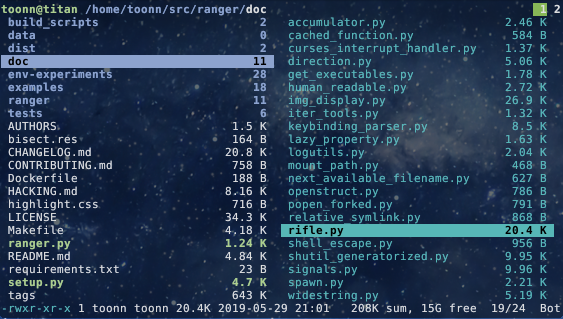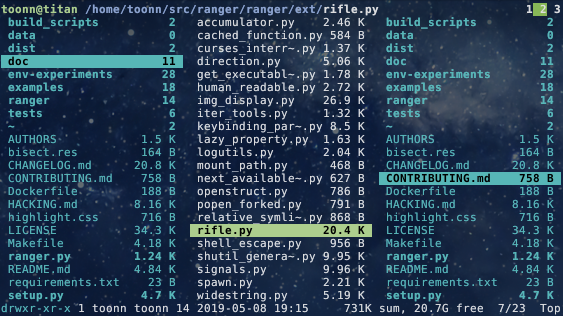ranger is a console file manager with VI key bindings. It provides a
minimalistic and nice curses interface with a view on the directory hierarchy.
It ships with rifle, a file launcher that is good at automatically finding
out which program to use for what file type.
For mc aficionados there's also the multi-pane viewmode.
This file describes ranger and how to get it to run. For instructions on the
usage, please read the man page (man ranger in a terminal). See HACKING.md
for development-specific information.
For configuration, check the files in ranger/config/ or copy the
default config to ~/.config/ranger with ranger --copy-config
(see instructions).
The examples/ directory contains several scripts and plugins that demonstrate how
ranger can be extended or combined with other programs. These files can be
found in the git repository or in /usr/share/doc/ranger.
A note to packagers: Versions meant for packaging are listed in the changelog on the website.
- Authors: see
AUTHORSfile - License: GNU General Public License Version 3
- Website: https://ranger.github.io/
- Download: https://ranger.github.io/ranger-stable.tar.gz
- Bug reports: https://github.com/ranger/ranger/issues
- git clone https://github.com/ranger/ranger.git
- An easily maintainable file manager in a high level language
- A quick way to switch directories and browse the file system
- Keep it small but useful, do one thing and do it well
- Console-based, with smooth integration into the unix shell
- UTF-8 Support (if your Python copy supports it)
- Multi-column display
- Preview of the selected file/directory
- Common file operations (create/chmod/copy/delete/...)
- Renaming multiple files at once
- VIM-like console and hotkeys
- Automatically determine file types and run them with correct programs
- Change the directory of your shell after exiting ranger
- Tabs, bookmarks, mouse support...
- Python (
>=2.6or>=3.1) with thecursesmodule and (optionally) wide-unicode support - A pager (
lessby default)
Optional:
- The
fileprogram for determining file types - The Python module
chardet, in case of encoding detection problems sudoto use the "run as root" featurew3mfor thew3mimgdisplayprogram to preview imagespython-bidifor correct display of RTL file names (Hebrew, Arabic)
Optional, for enhanced file previews (with scope.sh):
img2txt(fromcaca-utils) for ASCII-art image previewshighlightorpygmentizefor syntax highlighting of codeatool,bsdtarand/orunrarfor previews of archiveslynx,w3morelinksfor previews of html pagespdftotextormutoolforpdfpreviewstransmission-showfor viewing BitTorrent informationmediainfoorexiftoolfor viewing information about media filesodt2txtfor OpenDocument text files (odt,ods,odpandsxw)chardet(Python package) for improved encoding detection of text files
Use the package manager of your operating system to install ranger.
You can also install ranger through PyPI: pip install ranger-fm.
Note that you don't have to install ranger; you can simply run ranger.py.
To install ranger manually:
sudo make install
This translates roughly to:
sudo python setup.py install --optimize=1 --record=install_log.txt
This also saves a list of all installed files to install_log.txt, which you can
use to uninstall ranger.
After starting ranger, you can use the Arrow Keys or h j k l to
navigate, Enter to open a file or q to quit. The third column shows a
preview of the current file. The second is the main column and the first shows
the parent directory.
Ranger can automatically copy default configuration files to ~/.config/ranger
if you run it with the switch --copy-config=( rc | scope | ... | all ).
See ranger --help for a description of that switch. Also check
ranger/config/ for the default configuration.


